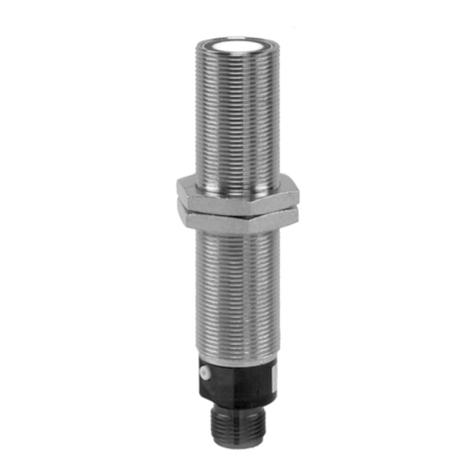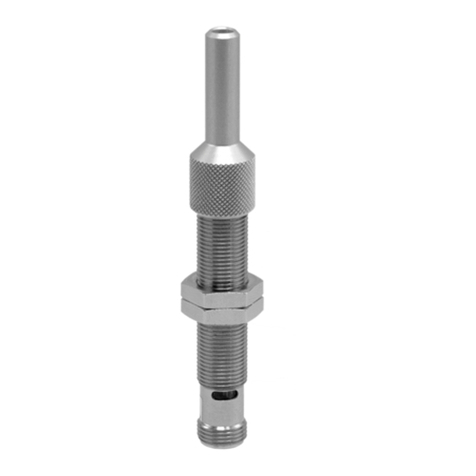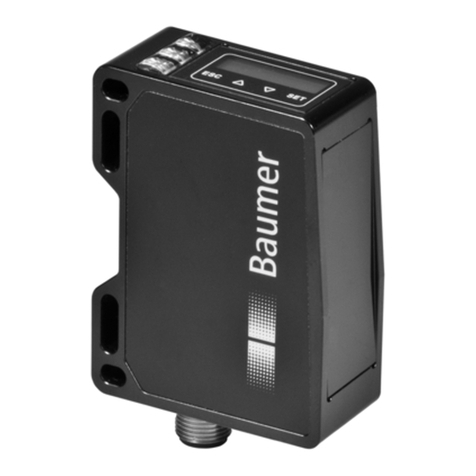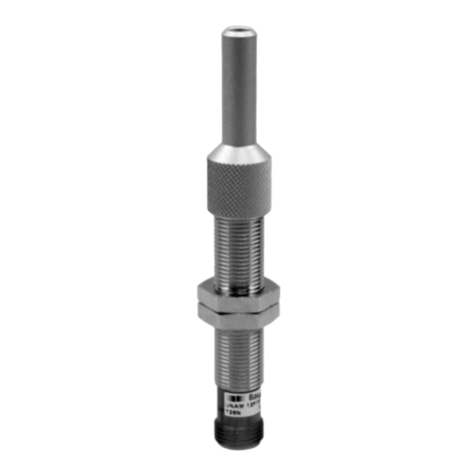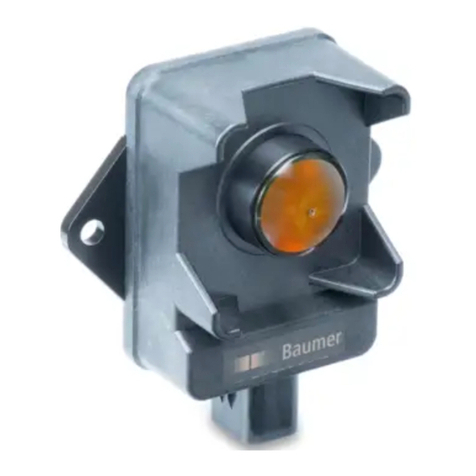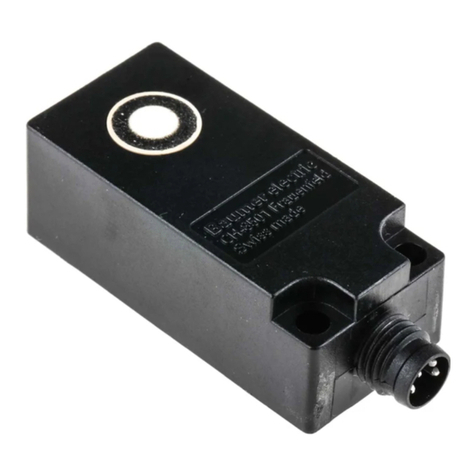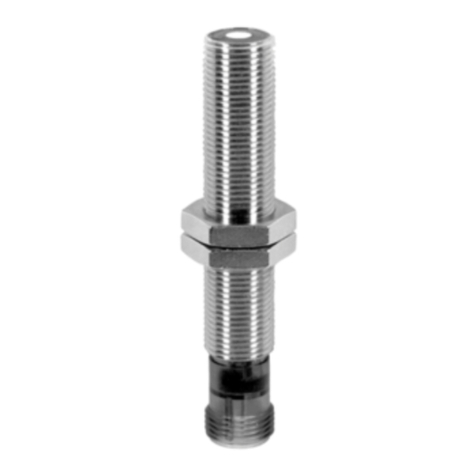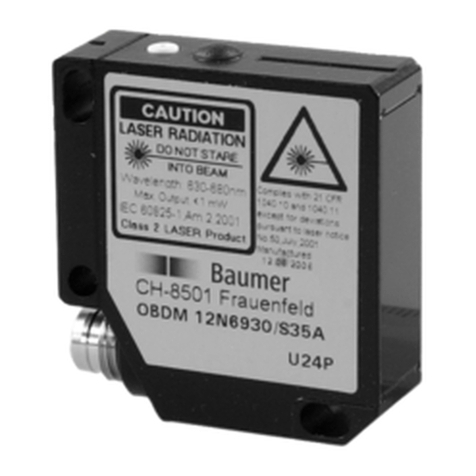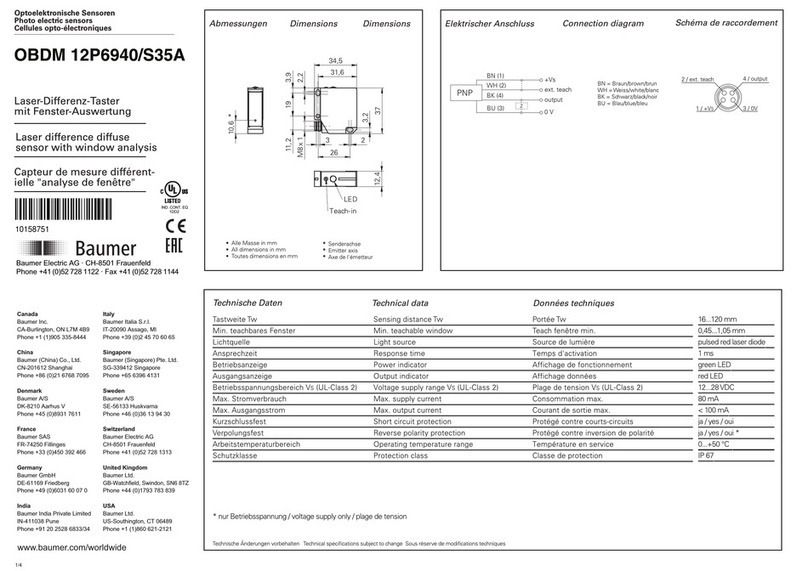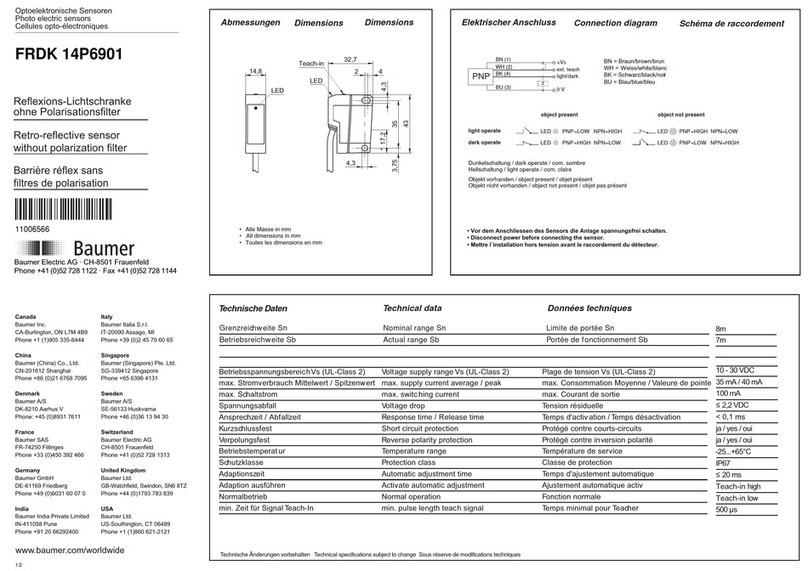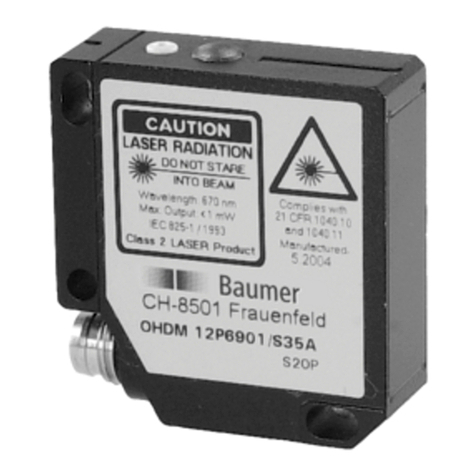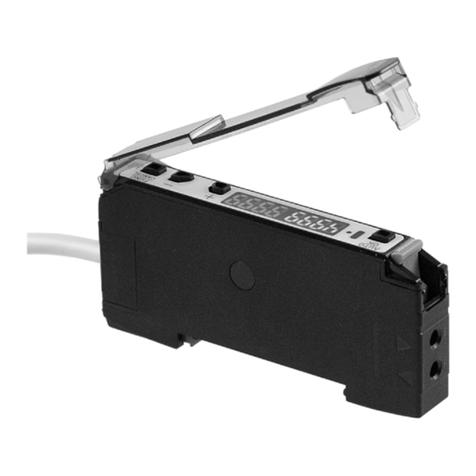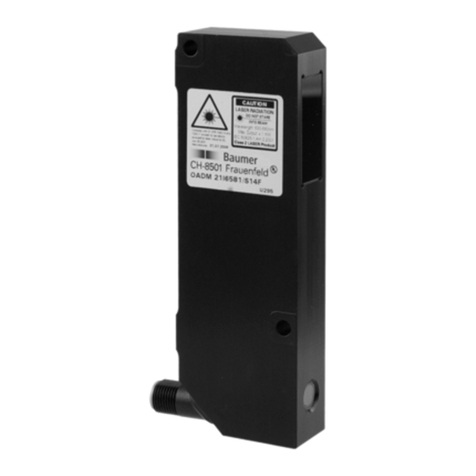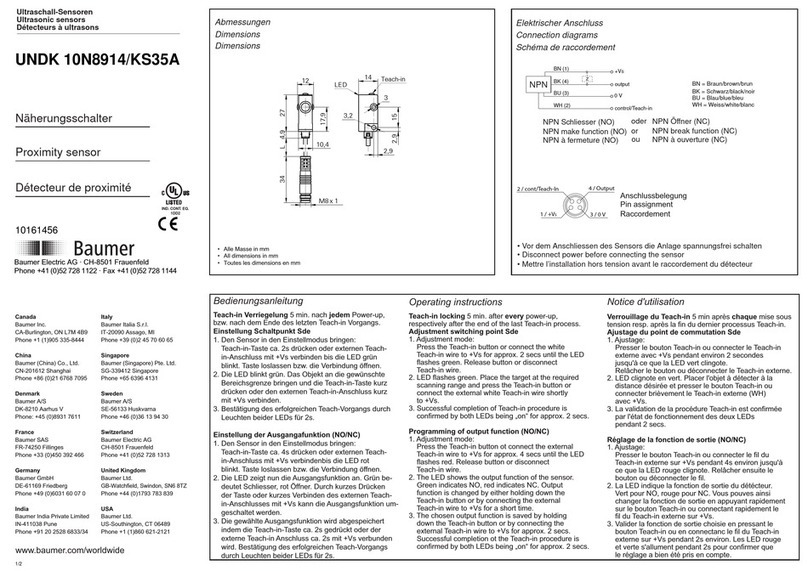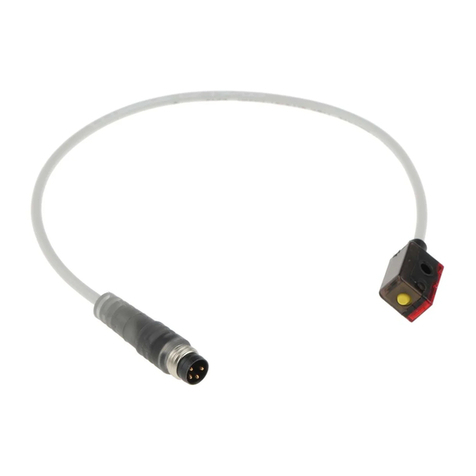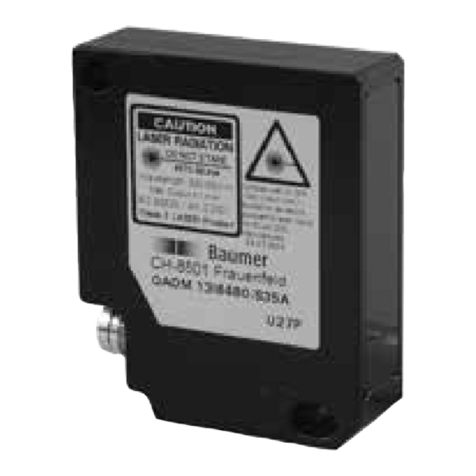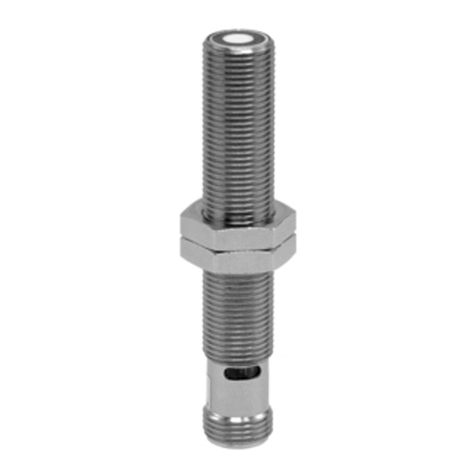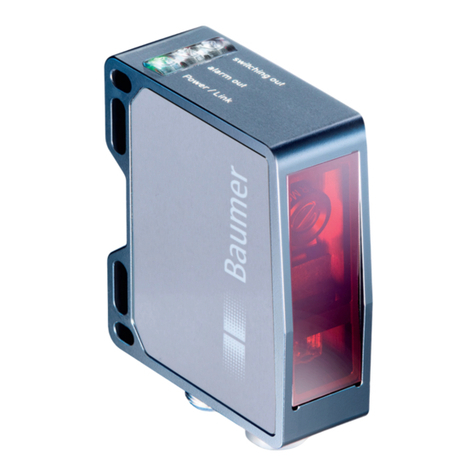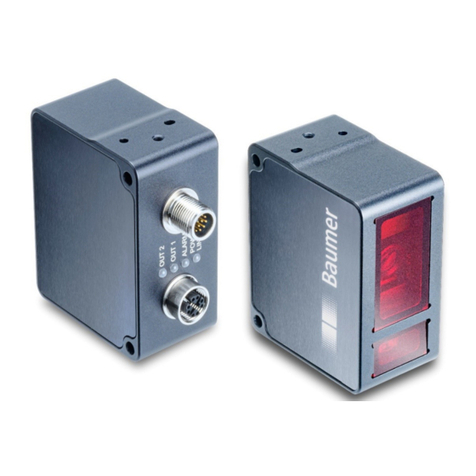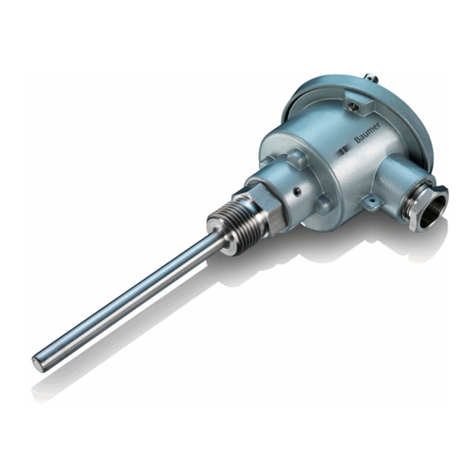
4/4
Baumer electric
CH-8501 Frauenfeld Hummelstrasse 17
Telefon 0527281122 Fax 052 7281144
Swiss made
FKDM 22P1902/S14F
ein
Ausgänge
aus
passiv
Sync.-Eingang
aktiv
max. 340µsmax. 140µs
Bedienungsanleitung
Manuel d'instruction
User Manual
Bemerkung: Der sichtbare Messfleck ist immer vorhanden, unabhängig vom
Status des Synchronisations-Signales.
Typische Anwendung ist z. B. ein mehrfarbiges Objekt, bei dem nur an einem
bestimmten Ort die Farbe überprüft werden soll und andere Bereiche
auszublenden sind. Auch Fehldetektionen beim Übergang vom Objekt zum
Hintergrund können so verhindert werden.
5. Extern-Lern-Modus (ExternTeach Eingang)
Mit diesem Signaleingang ist die vollständige Fernsteuerbarkeit des Sensors
möglich. Alle Bedienfunktionen wie Kanalwahl oderToleranzwahl sind über
eine serielle Schnittstelle ähnlich RS 232 zugänglich. Dabei ist 'ExternTeach'
der Eingang zum Sensor und 'Out 1' dessen Ausgang für Rückmeldungen
vom Sensor. Die beiden Signalleitungen 'ExternTeach' und 'Out 1' müssen
über einen Pegelwandler mit der anwenderseitigen RS-232-Schnittstelle ver-
bunden werden (Bestellnummer anfragen). Die Datenübertragung erfolgt mit
9600 Baud, ohne Parity, mit 8 Datenbits und einem Stoppbit.
Um in den Extern-Lern-Modus zu kommen, muss der Sync. Eingang während
mind. 300ms passiv sein.
Folgende Befehle, welche viaTerminal im ASCII-Format eingegeben werden,
stehen zurVerfügung:
@Startbefehl für den externen Lern-Modus (zusammen mit
Sync. passiv).
cx<CR><LF> Wahl des Kanals (channel). Der Parameter x[1..2]
bezeichnet den entsprechenden Kanal.
tx<CR><LF> Wahl derToleranz (tolerance). Der Parameter x[1..5]
bezeichnet die entsprechendeToleranzstufe.
e <CR><LF> Ausführungsbefehl (execute). Mit dem Ausführungsbefehl
wird der zuvor eingestellte Kanal mit der gewähltenToleranz
eingelernt, abgespeichert.
Ist vor dem Ausführungsbefehl kein Kanal und/oder keine
Toleranz selektiert worden, wird der Befehl ignoriert und vom
Sensor eine Fehlermeldung ausgegeben.
Ist das zu lernende Objekt zu hell oder zu dunkel, wird der
Befehl ignoriert und eine entsprechende Fehlermeldung
zurückgeschickt.
q <CR><LF> Externen Lern-Modus verlassen, ohne speichern.
Folgende Meldungen werden im externen Lern-Modus vom Sensor zurück-
gemeldet:
<SPC> ok <CR><LF> o.k.
Der zuvor eingegebene Befehl wurde ausgeführt.
<SPC> ?? <CR><LF> Allgemeiner Fehler.
Diese Fehlermeldung erfolgt in den folgenden Fällen:
-Befehl konnte nicht interpretiert werden (ungültige
Eingabe).
-Parameter liegt ausserhalb des Gültigkeitsbereiches.
-Vor dem Ausführungsbefehl (e) ist keineToleranz
und/oder kein Kanal gewählt worden.
<SPC> hi <CR><LF> Zu hohe Intensität. Das Objekt ist zu hell oder
glänzend.
<SPC> lo <CR><LF> Zu niedrige Intensität. Das Objekt ist zu dunkel.
Note:The visible measurement mark is always present irrespective of the
status of the synchronisation signal.
A typical application is e. g. a multi-coloured object where the colour is to
be checked at a particular place only and the other areas have to be faded
out. Incorrect detection during transition from the object to the back-
ground can therefore be avoided.
5. External learning mode (external teaching input)
Complete remote control of the sensor is possible using this signal input.
All control functions such as channel selection or tolerance selection can
be accessed via a serial interface similar to RS 232. In this case, 'external
teaching' is the input for the sensor and 'Out 1' is its output for feedback
from the sensor. Wiring of both 'external teaching' and 'Out 1' leads with
the user's RS-232 interface must be routed via a converter (ask for
availability). Data is transferred at 9600 baud, without parity, with 8 data
bits and one stop bit.
In order to access external learning mode, the sync. input must be
passive for at least 300ms.
The following commands which are entered via the terminal in ASCII
format, are available:
@Start command for the external learning mode
(together with passive sync.).
cx<CR><LF> Channel selection.The parameter x[1..2] designates
the relevant channel.
tx<CR><LF> Tolerance selection.The parameter x[1..5] designates
the relevant tolerance level.
e <CR><LF> Execute command.The previously selected channel
and previously selected tolerance is learned and stored
using the execute command.
If no channel and/or tolerance was selected before
actuating the execute command, the command is igno-
red and an error message is issued from the sensor.
If the object to be stored is too light or too dark, the
command is ignored and a corresponding error
message is sent back.
q <CR><LF> Quitting the external learning mode, without storing.
The following messages are sent back from the sensor in external
learning mode:
<SPC> ok <CR><LF> o.k.
The command previously entered is executed.
<SPC> ?? <CR><LF> General error.
This error message is issued in the following cases:
-Command could not be interpreted (invalid input).
-Parameter is outside the valid range.
-No tolerance and/or channel was selected
before the execute command (e) was actuated.
<SPC> hi <CR><LF> Intensity is too high.The object is too light or
too shiny.
<SPC> lo <CR><LF> Intensity is too low.The object is too dark.
Remarque: le point de mesure lumineux est toujours visible indépendam-
ment des signaux de synchronisation.
Une application typique serait d'identifier une couleur sur un objet à
couleurs multiples, ceci à un endroit définit sur l'objet et d'ignorer toutes
les autres zones colorées. D'autre part, des erreurs de détection provenant
du passage de l'objet à l'arrière-plan peuvent être supprimées.
5. Mode d'apprentissage automatique (entrée teach-in externe)
Cette entrée de signal permet de télécommander les fonctions du détecteur.
Toutes les fonctions telles que choix du canal ou de la tolérance sont acces-
siblent par cette interface sérielle idem à RS 232. Le 'Ext.Teach' est l'entrée
au détecteur et le 'Out 1' le retour des informations. Les deux signaux 'Ex-
ternTeach' et 'Out 1' doivent être reliés avec l'interface RS-232 du côté de
l'utilisateur, à travers un convertisseur (demandez la disponibilité).
La transmission est réalisée à 9600 Baud, sans Parity, avec 8 bits de
données et un bit de stop.
Pour accéder au mode d'apprentissage automatique, l'entrée de
synchronisation doit être sur passif un minimum de 300 ms.
Les ordres suivants, transmis via terminal en format ASCII, sont disponibles:
@Start du mode d'apprentissage automatique
(simultanément avec synch. sur passif).
cx<CR><LF> Choix des canaux. Le paramètre x[1..2] définit le canal
correspondant.
tx<CR><LF> Choix de la tolérance. Le paramètre x[1..5] désigne le
degré de tolérance choisit.
e <CR><LF> Ordre d'exécution (execute). L'ordre d'exécution permet
de programmer le canal sélectionné préalablement avec
sa tolérance.
Si aucun canal ou tolérance n'a été sélectionné au mo-
ment de l'ordre d'exécution, celui-ci ignorera l'ordre de
programmation et le détecteur renvera un signal d'erreur
correspondant. Si la couleur de l'objet est trop clair ou
sombre, l'ordre d'exécution sera ignoré et un signal
d'erreur correspondant viendra en retour.
q <CR><LF> Quitter le mode d'apprentissage automatique, sans
mémorisation.
Les informations suivantes viennent en retour du détecteur en mode
d'apprentissage automatique:
<SPC> ok <CR><LF> o.k.
L'ordre donné a été effectué.
<SPC> ?? <CR><LF> Erreur commune.
Cette information vient dans les cas suivants:
-l'ordre ne peut être interprèté (fausse introduction).
-les paramètre sont en dehors de la zone autorisée.
-Aucun canal ou tolérance n'a été sélectionné
avant l'ordre d'exécution.
<SPC> hi <CR><LF> -Intensité trop élevée. L'objet est trop clair ou
brillant..
<SPC> lo <CR><LF> -Intensité trop faible. L'objet est trop sombre.
on
output
off
passive
Sync.-input
active
max. 340µsmax. 140µs
on
Sorties
off
passif
Entrée synch.
actif
max. 340µsmax. 140µs
